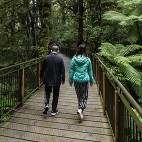Milford Opportunities
The Milford Opportunities Project is exploring ways to do tourism differently at Piopiotahi and along the Milford Road corridor for the benefit of people and place. It’s a key government-funded initiative, overseen by the Ministers of Conservation, Tourism and Transport alongside Ngāi Tahu, to look beyond current constraints and think about how to best implement a self-funded, sustainable tourism system.
Guiding vision and pillars
'Piopiotahi - New Zealand as it was, forever'

Mana Whenua values woven through
Iwi place in the landscape and guardianship of mātauranga Māori me te taiao (Māori knowledge and the environment) are recognised. Authentic mana whenua stories inform and contribute to a unique visitor experience

A moving experience
Visitors experience the true essence, beauty and wonder of Milford Sound Piopiotahi and Murihiku/Southland through curated story-telling, sympathetic infrastructure and wide choices suited to a multi-day experience

Tourism funds conservation and community
The visitor experience will become an engine for funding conservation growth and community prosperity

Effective visitor management
Visitors are offered a world class visitor experience that fits with the unique natural environment and rich cultural values of the region

Resilient to change and risk
Activities and infrastructure are adaptive and resilient to change and risk, for instance avalanche and flood risks, changing visitor trends, demographics and other external drivers

Conservation
Manage Fiordland National Park to ensure ongoing protection of pristine conservation areas, while enabling restoration of natural ecological values in other areas
Harness innovation and technology
Leading technology and innovation is employed to ensure a world class visitor experience now and into the future
How we began
Located in part of New Zealand’s largest National Park (Fiordland), Milford Sound Piopiotahi is one of New Zealand’s most popular visitor attractions and iconic destinations in the world.
In the 6 years between 2012 and 2018 the number of visitors to Piopiotahi Milford Sound more than doubled from approximately 437,000 to 883,000. Many of these were day-trippers from Queenstown – spending eight hours of their day in a bus or car. As these visitor numbers rose, so did the pressure on the natural environment and limited infrastructure in this remote World Heritage Area and final masterpiece of Tū Te Rakiwhānoa.
In 2017, DOC and Southland District Council raised the flag to say new thinking was required to protect the area’s conservation values and deliver a safer, deeper visitor experience.
While visitors continue to have memorable experiences in this place, the current Milford Road corridor and Piopiotahi itself are under stress. This requires new thinking to safeguard the core character and values, World Heritage status, conservation values and the visitor experience.
The project was included in the Southland Regional Development Strategy and in 2017 a governance group was created to look at how the future of Milford Sound Piopiotahi, the road, the Te Anau basin and the wider region should be developed and managed.
Original members included representatives from iwi, Southland District Council, Queenstown Lakes District Council, Department of Conservation, New Zealand Transport Agency, Ministry of Business, Innovation and Employment, and two tourism business operators. The governance group was led by independent chair Dr Keith Turner.
Project Stages 1, 2 and 3
The Milford Opportunities Project involves three stages:
- Stage 1: establishing context, vision and objectives (completed in
September 2018). - Stage 2: consultation, engagement and research to develop a Milford
Opportunities Masterplan (launched in July 2021). - Stage 3:
- Phase 1 (current phase): testing the feasibility of the masterplan’s
recommendations. - Phase 2: design, planning and implementation
- Phase 1 (current phase): testing the feasibility of the masterplan’s
Stage one was to establish context, vision and objectives and was completed in September 2018. Key to this stage was the development of the project’s working vision and pillars.
In stage two, consultants carried out extensive engagement to develop research papers to back up options chosen for the masterplan.
Alongside the research work, engagement with the community, key stakeholders, national interests and the New Zealand public was held over the 18 months of the development of the masterplan. Two nationwide surveys asking questions around the ideas received in the engagement meetings, surveys, and reference groups were held in July and October 2020.
The research and engagement findings helped the governance group make the final decisions on the concepts and recommendations which are included in the masterplan.
The masterplan went to ministers in May 2021 and then to Cabinet in June 2021.
It was then launched to the public in Te Anau on 28 July 2021.
Currently, the Milford Opportunities Project is in Stage 3, Phase 1, focussed on testing the feasibility of the masterplan’s key concepts, including a significant programme of public and stakeholder engagement.
